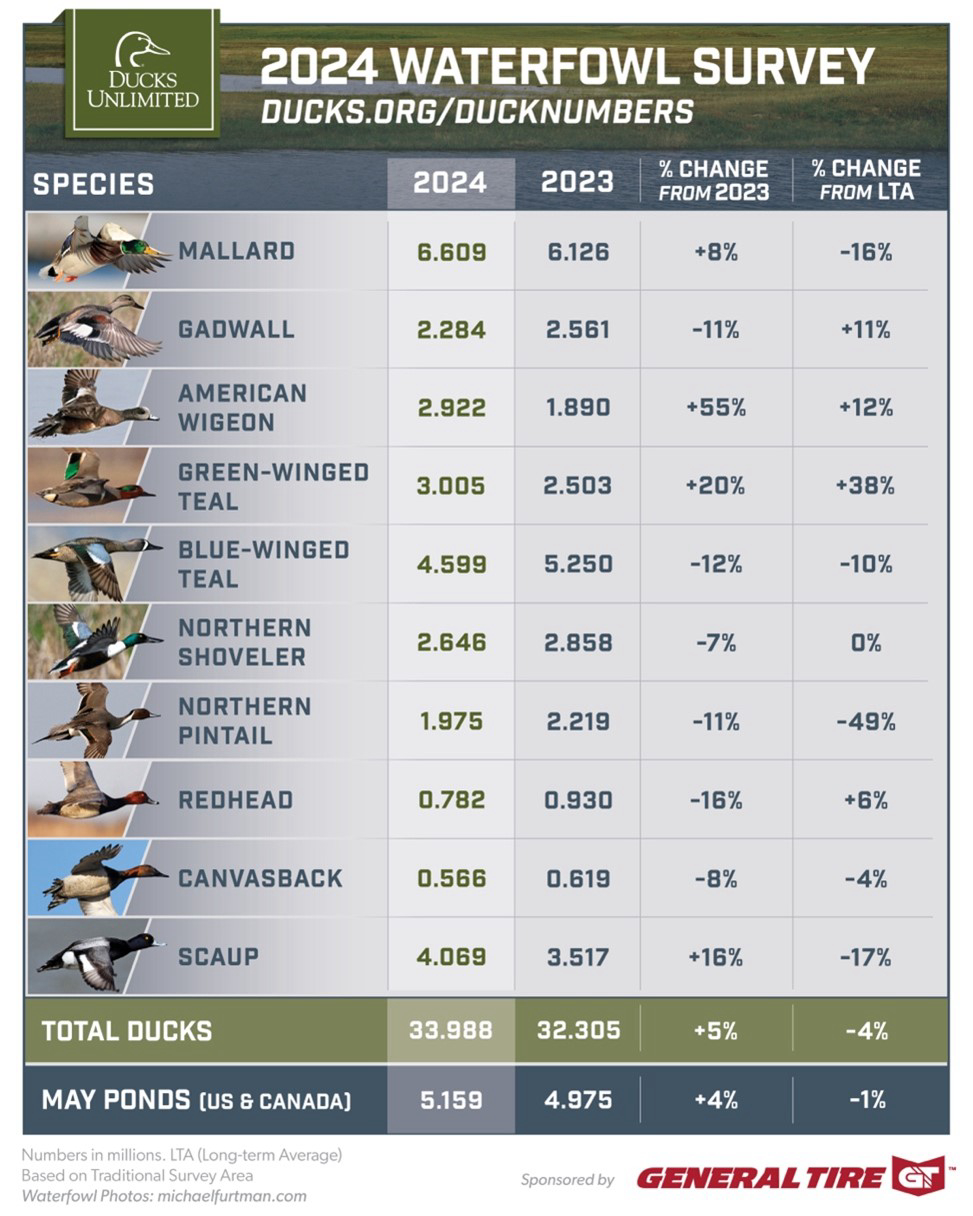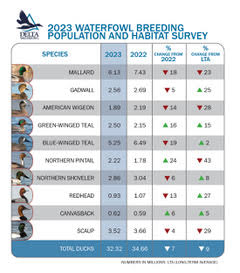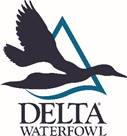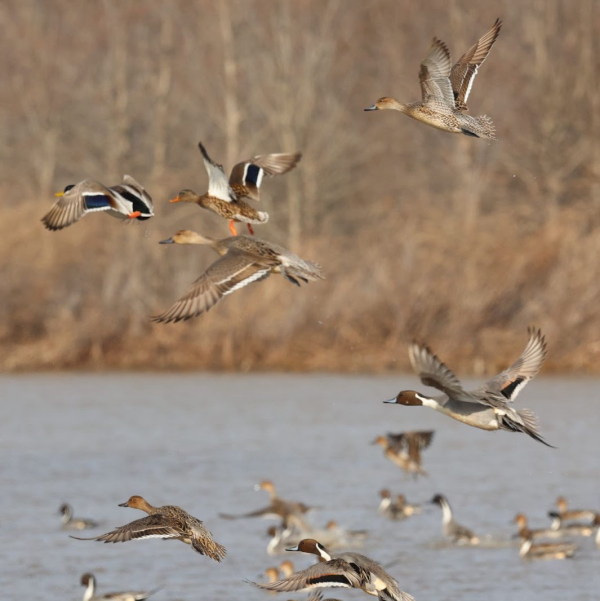2023 Waterfowl Population Survey Results
From Matt Harrison, Duck Unlimited
A 7% drop in population estimates underscores need for continued conservation
MEMPHIS, Tenn. – Aug. 18, 2023 – The U.S. Fish and Wildlife Service (FWS)released its report on 2023 Waterfowl Population Status based on surveys conducted in May and early June by FWS, Canadian Wildlife Service and other partners.
Total populations were estimated at 32.3 million breeding ducks in the traditional survey area, a 7% drop from 2022’s estimate of 34.7 million and 9% below the long-term average (since 1955).
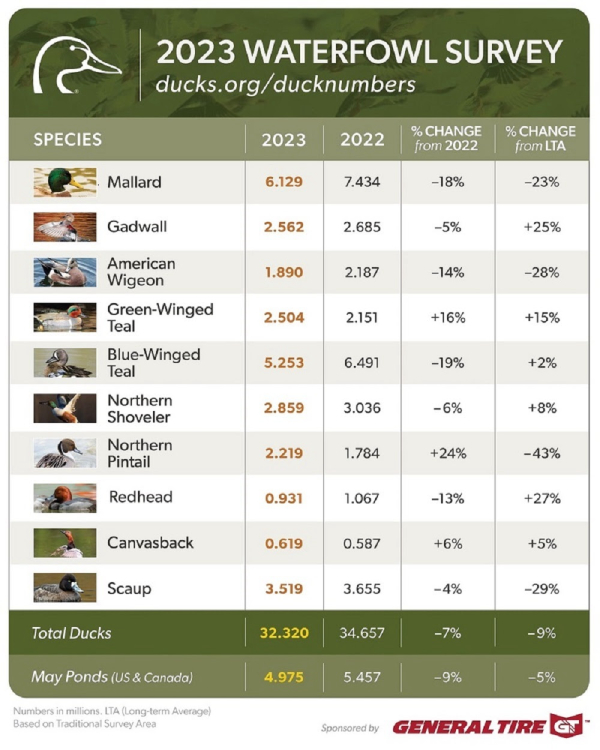
DU Chief Scientist Dr. Steve Adair said the overall numbers reflect a complex relationship between waterfowl, weather and habitat availability.
“These results are somewhat disappointing, as we had hoped for better production from the eastern prairies following improved moisture conditions in spring of 2022,” Adair said. “Last year’s nesting season was delayed with April snowstorms and May rains which likely impacted overall production. In the past, we have seen population growth lag moisture conditions as small, shallow wetlands recover from the lingering impacts of severe drought.”
Key takeaways
- Populations of most species remain healthy and near the long-term averages, which should produce a respectable flight for waterfowl hunters and waterfowl enthusiasts to enjoy this fall and winter.
- Total pond numbers in the U.S. and Canada were estimated at 5 million, which was 9% lower than the 2022 estimate of 5.5 million and slightly below the long-term average of 5.2 million.
- Mallard and American wigeon populations declined. Estimates for mallards were down 18% from 2022 and 23% from their long-term average. American wigeon were down 14% from 2022 and 28% from their long-term average. These declines are a concern for DU scientists and amplify the need for sustained investments in conservation, monitoring and targeted science.
- Pintails provided a noteworthy bright spot. Population estimates increased 24% over the record low from last year. Although the survey showed that overall duck populations remain healthy, it also told a story of continuing drought in the western Canadian prairie provinces, which will limit production for ducks that traditionally settle in those landscapes.
- Subsequent surveys will paint a more complete picture of how well duck populations are recovering from the severe drought of 2020 –2021.
- Highly pathogenic avian influenza – Based on reports from waterfowl managers and wildlife disease experts of partner agencies, DU scientists don’t expect a significant impact on duck populations from the HPAI outbreak of 2022.
Background
The breeding surveys that evolved into the Waterfowl Breeding Population and Habitat Survey began in 1947. The primary purpose of the WBPHS is to provide information on spring population size and trajectory for 19 North American duck species, or species groups, Canada Geese and swans, and to evaluate habitat conditions in the prairies by counting waterfowl breeding ponds.
Data collected from the survey are used to inform hunting regulations in the United States and Canada and provide vital information for researching relationships between waterfowl and their habitats, which are critical to effective conservation planning. The results are eagerly awaited by waterfowlers, scientists and other bird enthusiasts.
Each spring, the U.S. Fish and Wildlife Service and Canadian Wildlife Service send air and ground crews into the 2-million-acre survey area, which stretches from Alaska’s Seward Peninsula to the shores of Newfoundland, and south nearly to the Nebraska?South Dakota border. The CWS also operates three helicopter air crews who survey portions of eastern Canada. For weeks, teams fly, drive and hike survey routes across vast landscapes and numerous types of waterfowl habitats. Although many of these areas have remained largely unchanged for over 50 years, others are seeing increasing pressures from alternative land uses and environmental change.
Fly along: This spring, Ducks Unlimited joined the U.S. Fish and Wildlife Service as they flew the breeding grounds. Watch the adventures and learn about the process on this episode of DU Nation.
What’s next
“We remain concerned about the continuing loss and degradation of habitat in the prairies and long-term impacts on carrying capacity and productivity,” Adair said.
Regardless of pond counts and precipitation, waterfowl need productive habitat across their lifecycle to breed, migrate and winter successfully. Ducks Unlimited, in partnership with the U.S. Fish and Wildlife Service and numerous other governmental, nonprofit and corporate partners, recently surpassed 16 million acres of protected or restored waterfowl habitat.
Ducks Unlimited continues to establish innovative research projects to better understand the needs of waterfowl and better guide conservation efforts. And landowners are a crucial component of healthy landscapes. Farmers and private landowners – with help from voluntary incentive-based programs in the U.S. Farm Bill – can help conservation organizations produce healthier wetlands and grasslands.
The united effort to protect wetlands has paid off over many decades: a recent State of the Birds report shows waterfowl and other wetland-dependent birds are the only species to increase in numbers since the 1970s, primarily because of conservation efforts.
“Lower than expected numbers in this year’s survey reinforce the need for wetlands conservation as habitat continues to be lost across the continent,” said Ducks Unlimited CEO Adam Putnam. “For over 86 years DU has focused on North American wetlands and grasslands that sustain healthy waterfowl populations, and support clean water for people, too. As much as we have accomplished, these data confirm we have more work to do.”
To invest in ’s wetlands and waterfowl populations, Ducks Unlimited, Ducks Unlimited Canada, Ducks Unlimited de Mexico and Wetlands America Trust have joined forces to launch Conservation For a Continent, a historic $3 billion capital campaign. Conservation For a Continent is one of the largest North American fundraising efforts to support habitat protection and restoration. Learn more about this effort.
View the full bird population report here.
Ducks Unlimited Inc. is the world‘s largest nonprofit organization dedicated to conserving North America’s continually disappearing waterfowl habitats. Established in 1937, Ducks Unlimited has conserved more than 16 million acres thanks to contributions from more than a million supporters across the continent. Guided by science and dedicated to program efficiency, DU works toward the vision of wetlands sufficient to fill the skies with waterfowl , and forever. For more information on our work, visit www.ducks.org.


